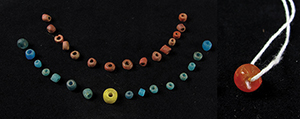Crossref Citations
This article has been cited by the following publications. This list is generated based on data provided by
Crossref.
2017.
First Islanders.
p.
312.
Hung, Hsiao-chun
2017.
Handbook of East and Southeast Asian Archaeology.
p.
633.
Ono, Rintaro
Oktaviana, Adhi Agus
Ririmasse, Marlon
Takenaka, Masami
Katagiri, Chiaki
and
Yoneda, Minoru
2018.
Early Metal Age interactions in Island Southeast Asia and Oceania: jar burials from Aru Manara, northern Moluccas.
Antiquity,
Vol. 92,
Issue. 364,
p.
1023.
Wang, Kuan-Wen
Iizuka, Yoshiyuki
Hsieh, Yi-Kong
Lee, Kun-Hsiu
Chen, Kwang-Tzuu
Wang, Chu-Fang
and
Jackson, Caroline
2019.
The anomaly of glass beads and glass beadmaking waste at Jiuxianglan, Taiwan.
Archaeological and Anthropological Sciences,
Vol. 11,
Issue. 4,
p.
1391.
Nikolsky, Aleksey
2020.
The Origins of Language Revisited.
p.
217.
Selvakumar, V.
2020.
Asia-Africa Growth Corridor.
p.
235.
Nikolsky, Aleksey
Alekseyev, Eduard
Alekseev, Ivan
and
Dyakonova, Varvara
2020.
The Overlooked Tradition of “Personal Music” and Its Place in the Evolution of Music.
Frontiers in Psychology,
Vol. 10,
Issue. ,
Wang, Li-Ying
and
Marwick, Ben
2020.
Trade ornaments as indicators of social changes resulting from indirect effects of colonialism in northeastern Taiwan.
Archaeological Research in Asia,
Vol. 24,
Issue. ,
p.
100226.
JENCO, LEIGH K.
2021.
CHEN DI'SRECORD OF FORMOSA(1603) AND AN ALTERNATIVE CHINESE IMAGINARY OF OTHERNESS.
The Historical Journal,
Vol. 64,
Issue. 1,
p.
17.
Wang, Kuan-Wen
Iizuka, Yoshiyuki
Jackson, Caroline
and
Biehl, Peter F.
2022.
The production technology of mineral soda alumina glass: A perspective from microstructural analysis of glass beads in Iron Age Taiwan.
PLOS ONE,
Vol. 17,
Issue. 2,
p.
e0263986.
Hudson, Mark
2022.
Bronze Age Maritime and Warrior Dynamics in Island East Asia.
Lescure, Javier
Cancio, Carlos
Garong, Ame
Quinto‐Sanchez, Mirsha
González‐José, Rolando
and
González‐Martín, Antonio
2022.
Admixture and population dynamics in the Philippines through craniometric analysis.
International Journal of Osteoarchaeology,
Vol. 32,
Issue. 5,
p.
1105.
Xu, Siwen
Qiao, Baotong
and
Yang, Yimin
2022.
The rise of the Maritime Silk Road about 2000 years ago: Insights from Indo-Pacific beads in Nanyang, Central China.
Journal of Archaeological Science: Reports,
Vol. 42,
Issue. ,
p.
103383.
Leipe, Christian
Lu, Jou-chun
and
Chi, Ko-an
2023.
Population dynamics in Taiwan from the Neolithic to early historic periods (5000–100 cal BP): Linking cultural developments and environmental change.
Archaeological Research in Asia,
Vol. 36,
Issue. ,
p.
100482.
Lin, Marie
and
Trejaut, Jean A.
2023.
Diversity and distribution of mitochondrial DNA in non-Austronesian-speaking Taiwanese individuals.
Human Genome Variation,
Vol. 10,
Issue. 1,
Abraham, Shinu Anna
2023.
Recent Developments in the Archaeology of Long-Distance Connections Across the Ancient Indian Ocean.
Annual Review of Anthropology,
Vol. 52,
Issue. 1,
p.
115.
Wang, Kuan-Wen
Dussubieux, Laure
Iizuka, Yoshiyuki
Li, Kuang-ti
and
Tsang, Cheng-hwa
2023.
Glass ornaments from southwestern Taiwan: new light on maritime glass exchange across Southeast, South and West Asia in the early-mid 1st millennium CE.
Heritage Science,
Vol. 11,
Issue. 1,
Wang, Weiwei
Nguyen, Khanh Trung Kien
Zhao, Chunguang
and
Hung, Hsiao-chun
2023.
Earliest curry in Southeast Asia and the global spice trade 2000 years ago.
Science Advances,
Vol. 9,
Issue. 29,
Leipe, Christian
Lu, Jou-chun
Chi, Ko-an
Lee, Shu-min
Yang, Hung-cheng
and
Wagner, Mayke
2023.
Archaeobotanical evidence of plant cultivation from the Sanbaopi site in south-western Taiwan during the Late Neolithic and Metal Age.
The Holocene,
Vol. 33,
Issue. 2,
p.
131.
Patnukao, Areerut
2024.
Revisiting moated sites in Northeast Thailand: integrating spatial analysis with previous and new research insights.
GeoJournal,
Vol. 89,
Issue. 5,
